Applications of the Bernoulli Equation
The Bernoulli equation can be applied to a great many situations not just the
pipe flow we have been considering up to now. In the following sections we will
see some examples of its application to flow measurement from tanks, within
pipes as well as in open channels.
1. Pitot Tube
If a stream of uniform velocity flows into a blunt body, the stream lines
take a pattern similar to this:
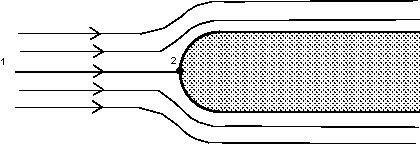
Streamlines around a blunt body
Note how some move to the left and some to the right. But one, in the centre,
goes to the tip of the blunt body and stops. It stops because at this point the
velocity is zero - the fluid does not move at this one point. This point is
known as the stagnation point.
From the Bernoulli equation we can calculate the pressure at this point.
Apply Bernoulli along the central streamline from a point upstream where the
velocity is u1 and the pressure p1 to the
stagnation point of the blunt body where the velocity is zero, u2
= 0. Also z1 = z2.
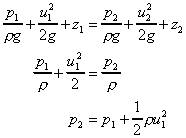
This increase in pressure which bring the fluid to rest is called the
dynamic pressure.
Dynamic pressure =

or converting this to head (using
 ) )
Dynamic head =

The total pressure is know as the stagnation pressure (or total
pressure)
Stagnation pressure =

or in terms of head
Stagnation head =

The blunt body stopping the fluid does not have to be a solid. I could be a
static column of fluid. Two piezometers, one as normal and one as a Pitot tube
within the pipe can be used in an arrangement shown below to measure velocity of
flow.
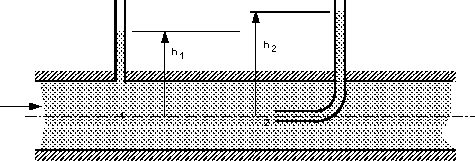
A Piezometer and a Pitot tube
Using the above theory, we have the equation for p2 ,

We now have an expression for velocity obtained from two pressure
measurements and the application of the Bernoulli equation.
2. Pitot Static Tube
The necessity of two piezometers and thus two readings make this arrangement
a little awkward. Connecting the piezometers to a manometer would simplify
things but there are still two tubes. The Pitot static tube combines the
tubes and they can then be easily connected to a manometer. A Pitot static tube
is shown below. The holes on the side of the tube connect to one side of a
manometer and register the static head, (h1), while the
central hole is connected to the other side of the manometer to register, as
before, the stagnation head (h2).
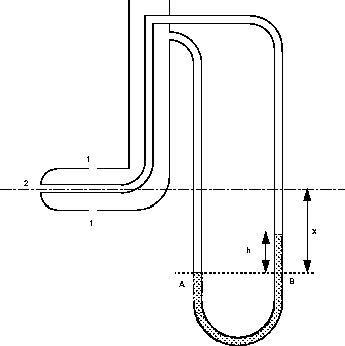
A Pitot-static tube
Consider the pressures on the level of the centre line of the Pitot tube and
using the theory of the manometer,

We know that
 ,
substituting this in to the above gives ,
substituting this in to the above gives

The Pitot/Pitot-static tubes give velocities at points in the flow. It does
not give the overall discharge of the stream, which is often what is wanted. It
also has the drawback that it is liable to block easily, particularly if there
is significant debris in the flow.
3. Venturi Meter
The Venturi meter is a device for measuring discharge in a pipe. It consists
of a rapidly converging section which increases the velocity of flow and hence
reduces the pressure. It then returns to the original dimensions of the pipe by
a gently diverging 'diffuser' section. By measuring the pressure differences the
discharge can be calculated. This is a particularly accurate method of flow
measurement as energy loss are very small.
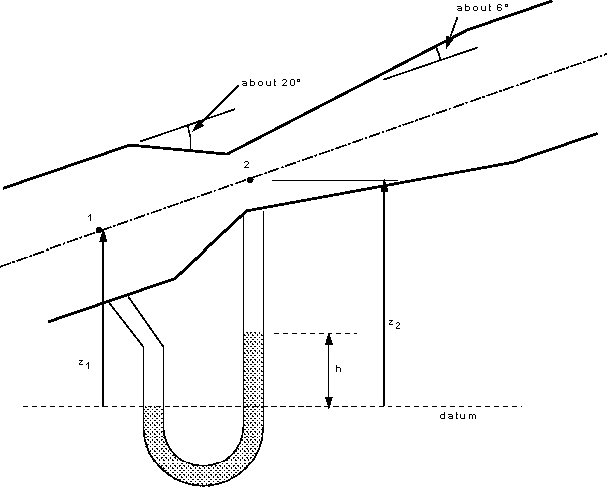
A Venturi meter
Applying Bernoulli along the streamline from point 1 to point 2 in the narrow
throat of the Venturi meter we have

By the using the continuity equation we can eliminate the velocity u2,

Substituting this into and rearranging the Bernoulli equation we get
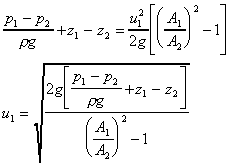
To get the theoretical discharge this is multiplied by the area. To get the
actual discharge taking in to account the losses due to friction, we include a
coefficient of discharge
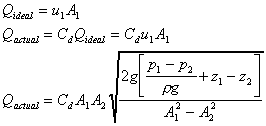
This can also be expressed in terms of the manometer readings

Thus the discharge can be expressed in terms of the manometer reading::
|

